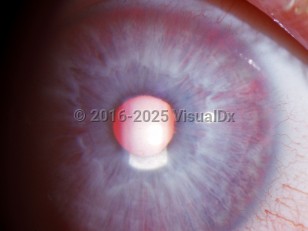Ocular albinism in Adult
Alerts and Notices
Important News & Links
Synopsis

Ocular albinism (OA) is a genetic disease characterized by impaired synthesis of the pigment melanin. There are 3 types of ocular albinism: type 1 (OA1), type 2, and ocular albinism with sensorineural deafness. OA1, also known as Nettleship-Falls syndrome, is the most common form; the other forms are rare.
OA is mainly caused by GPR143 gene mutations on the X chromosome, a gene providing instructions for making a protein responsible for eye and skin pigmentation. Rarely, OA is not caused by mutations in the GPR143 gene. In these specific cases, the cause of the condition has yet to be identified.
OA1 is inherited in an X-linked, autosomal recessive pattern. The classic clinical presenting signs and symptoms of OA1 are more common in males, while female carriers manifest few traits of the disease.
Clinical presentation typically includes a patient presenting with impaired visual acuity, stereoscopic vision, and photophobia. Other associated ocular symptoms include rapid, involuntary eye movements (nystagmus) and eyes that do not look in the same direction (strabismus). Many patients have abnormalities involving the optic nerves. Unlike other types of albinism, OA does not greatly affect skin and hair color. However, individuals with OA typically have a slightly lighter complexion than other family members.
OA is mainly caused by GPR143 gene mutations on the X chromosome, a gene providing instructions for making a protein responsible for eye and skin pigmentation. Rarely, OA is not caused by mutations in the GPR143 gene. In these specific cases, the cause of the condition has yet to be identified.
OA1 is inherited in an X-linked, autosomal recessive pattern. The classic clinical presenting signs and symptoms of OA1 are more common in males, while female carriers manifest few traits of the disease.
Clinical presentation typically includes a patient presenting with impaired visual acuity, stereoscopic vision, and photophobia. Other associated ocular symptoms include rapid, involuntary eye movements (nystagmus) and eyes that do not look in the same direction (strabismus). Many patients have abnormalities involving the optic nerves. Unlike other types of albinism, OA does not greatly affect skin and hair color. However, individuals with OA typically have a slightly lighter complexion than other family members.
Codes
ICD10CM:
E70.318 – Other ocular albinism
SNOMEDCT:
26399002 – Ocular albinism
E70.318 – Other ocular albinism
SNOMEDCT:
26399002 – Ocular albinism
Look For
Subscription Required
Diagnostic Pearls
Subscription Required
Differential Diagnosis & Pitfalls

To perform a comparison, select diagnoses from the classic differential
Subscription Required
Best Tests
Subscription Required
Management Pearls
Subscription Required
Therapy
Subscription Required
References
Subscription Required
Last Reviewed:08/29/2017
Last Updated:01/20/2022
Last Updated:01/20/2022

